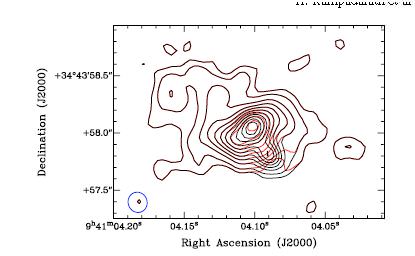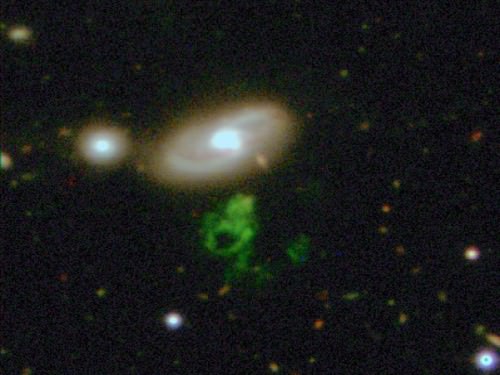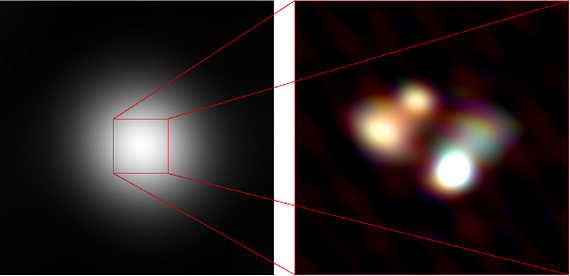[/caption]
Is Hanny’s Voorwerp the result of a “light echo” of a violent event that happened long ago or perhaps is this mystifying blob of glowing gas being fueled by an ongoing, and current phenomenon? A just-released paper about the Voorwerp offers a new explanation for this perplexing, seemingly one-of-a-kind object in the constellation of Leo Minor. If you haven’t heard the remarkable story, the object was discovered in 2007 by Dutch school teacher Hanny Van Arkel while she was classifying galaxies for the Galaxy Zoo online citizen science project. Until now, the working hypothesis for the explanation of this unusual object was that we might be seeing the “light echo” of a quasar outburst event that occurred millions of years ago. But new radio observations reveal that instead, a black hole in that same nearby galaxy might be producing a radio jet, shooting a thin beam directly at this cloud of gas, causing it to light up.
Hanny’s Voorwerp (Dutch for object) consists of dust and gas – but no stars – so astronomers know it is not a galaxy, even though it is galaxy-sized. Previously, astronomers studying the object thought the gas and dust were illuminated by a quasar outburst within the nearby galaxy IC 2497. While the outburst would have faded within the last 100,000 years, the light only reached the dust and gas in time for our telescopes to see the effect. But this explanation was slightly unsatisfactory in that such an event, where an entire galaxy would flare up suddenly and briefly, is unexplained.

But radio observations with the European Very Long Baseline Interferometry (VLBI) Network at 18 cm, and the Multi-Element Radio Linked Interferometer Network (MERLIN) at 18 cm and 6 cm show evidence of black hole, or active galactic nuclei (AGN) activity and a nuclear starburst in the central regions of IC 2497.
This event is hard to see from our vantage point on Earth because another cloud of dust and gas sits between us on Earth and IC 2497, preventing us from directly seeing the black hole.
“The new data shows that the nucleus continues to produce a radio jet, in about the direction of Hanny’s Voorwerp,” said Bill Keel from the University of Alabama, one of the astronomers who has been studying the object intently ever since its discovery, and was part of the new observations. “The core is still too weak in the radio to be able to conclude that it puts off enough UV and X-rays to light up the gas, however. There may well be interaction between outflowing material connected with the jet and the gas outside the galaxy, helping to shape the Voorwerp, but the spectra in the discovery paper already made it clear that the gas is ionized not by shocks from such an interaction, but by radiation. ”
Keel said, though, there is still remaining uncertainty — and different astronomers have varying estimates of this likelihood – of whether the radiation from the quasar core remains strong or whether it shoots in fits and starts.
“Some active galaxies put out a lot of energy in jets and outflows compared to radiation, and we are considering the possibility that this one has switched to such a “radio mode” in the recent past,” he said. “If so, the Voorwerp would be an ionization echo, or light echo, since the re-radiation from ionized gas is not instantaneous, as scattering is.”
The Voorwerp has captured enough attention and curiosity that astronomers have trained numerous telescopes on the object in an effort to sort out the mystery. But Keel said this approach is essential in eventually figuring this out.
“Each wavelength range gives us a different, and usually complementary, piece of the story,” he said. “The earlier radio data tell us something about where all that gas came from, and we got another connection from recent data putting an apparent companion spiral galaxy at the same distance as IC 2497. Even the early X-ray data showed us that there was an interesting puzzle as to why we didn’t see the core AGN. The GALEX UV spectrum is informing our interpretation of the Hubble UV image.”
Yes, Hubble recently looked at the Voorwerp in a couple of different wavelengths, (read our article about the Hubble observations here) and while Keel couldn’t comment directly about data from the iconic telescope, (everything is still being analyzed) he did say it holds some interesting surprises.
“One of the first things we started checking with Hubble data was whether we have a clear view in at least the infrared to the nucleus, starting from the location of the radio source,” he said. “Also, these results give us particular reason to look at the structural details of the gas in Hanny’s Voorwerp, for signs that it may be affected by an outflow from the nucleus. I can mention that there are some interesting surprises from the HST data, which is what we always hope for!”
Keel said he also has been observing at Kitt Peak, looking at other candidate “voorwerpjes” – similar “ionized clouds on a somewhat smaller scale around AGN, where the same lifetime-versus-obscuration issues apply but we can usually see the AGN responsible,” he said.
And look for some upcoming public outreach projects on the Voorwerp based on the Hubble data, as well, including one in Bloomington, Minnesota on July 1-4 at the CONvergence, where writers and scienctists will be writing a graphic novel based on the discovery of Hanny’s Voorwerp. Check out this website for more information.



